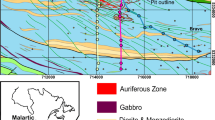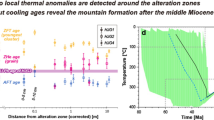Abstract
Whole rock oxygen isotope data are presented for the Panorama district, in the Archean Pilbara Craton of Western Australia, where near-perfect exposure reveals a cross section through a complete volcanogenic massive sulfide (VMS) hydrothermal alteration system. The δ18O values decrease with depth in the volcanic pile, across semi-conformable alteration zones, to values below 6‰ immediately above a large (180 km2) subvolcanic intrusion. Altered rocks in the upper parts of the subvolcanic intrusion have lower δ18O values (6–8‰) than least altered granite (8‰), apart from sericite–quartz altered zones, which are slightly higher (8–10‰). Corridors of low δ18O values crosscut this regional zonation, and are coincident with transgressive feldspar-destructive alteration zones, which underlie VMS mineralization. The whole rock oxygen isotope distribution patterns are interpreted to represent alteration temperature, where high δ18O values correspond to low temperature alteration and low δ18O values correspond to high temperature alteration. Alteration temperatures, which were calculated using modal alteration mineral abundances and an assumed fluid δ18O, are consistent with this interpretation. Increasing temperatures with depth in the volcanic pile and high temperatures in transgressive corridors leading up to VMS deposits, are consistent with a convective hydrothermal model, in which heat from the subvolcanic intrusion drove seawater through the volcanic pile. Granite-hosted sericite–quartz alteration zones are 18O-enriched, and are tentatively interpreted to have formed from a mixed magmatic-evolved seawater fluid.
Similar content being viewed by others
Author information
Authors and Affiliations
Additional information
Received: 12 April 1999 / Accepted: 6 April 2000
Rights and permissions
About this article
Cite this article
Brauhart, C., Huston, D. & Andrew, A. Oxygen isotope mapping in the Panorama VMS district, Pilbara Craton, Western Australia: applications to estimating temperatures of alteration and to exploration. Mineral. Deposita 35, 727–740 (2000). https://doi.org/10.1007/s001260050275
Issue Date:
DOI: https://doi.org/10.1007/s001260050275




